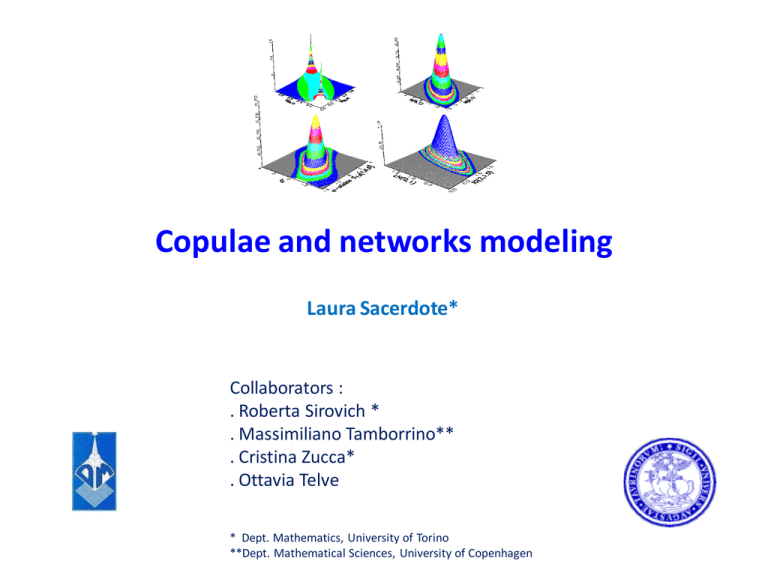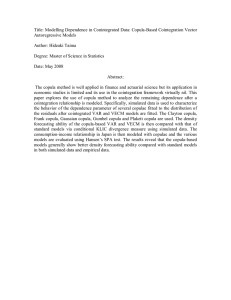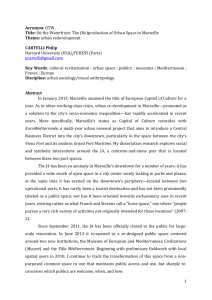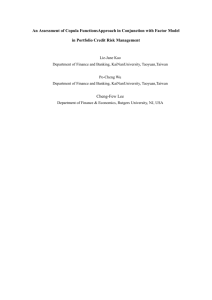Copulae and networks modeling Laura Sacerdote* Collaborators : . Roberta Sirovich *
advertisement

Copulae and networks modeling
Laura Sacerdote*
Collaborators :
. Roberta Sirovich *
. Massimiliano Tamborrino**
. Cristina Zucca*
. Ottavia Telve
* Dept. Mathematics, University of Torino
**Dept. Mathematical Sciences, University of Copenhagen
Summary
• Information transmission: single neuron - networks
• Dependencies measures
• First models using copulas
• Open problems and future work
Marseille, January 18-22,2010
Information transmission
Single neurons “code” the information through intertimes
between spikes
How the information propagates in the network?
Marseille, January 18-22,2010
Simultaneously recorded spike trains
Pattern can be observed
Marseille, January 18-22,2010
Analysis of the pattern
Different view points:
• Statistical
– Crosscorrelogram
– Spatio-temporal pattern detection method (Abeles)
• Mathematical Models for large networks
– Simulation approach
– Mean field approach, Master equations….
– Complex system approach
Both view points share the necessity to study dependencies between the
point processes describing the spike trains
Marseille, January 18-22,2010
Models
• We have “good” mathematical models describing single
neuron spike activity;
– they repoduce main observed features of the neuron;
– they help our understanding of these features (role of noise, effect of
periodic stimula…)
• Separately we have network models:
– Large networks: simulation of oversimplified units with adaptive
connections; object oriented networks; multiparticles systems; limit
theorems for large systems,…
– Small networks: jump-diffusion models; Hodkin-Huxley like model
neuron network
How to insert single neuron models in network models?
Marseille January 18-22,2010
Copulae: mathematical objects catching
dependencies
Consider two random variables X1 and X2 their distribution F(x1,x2)
completely describes their joint behavior:
F(x1, x2) = P(X1<x1, X2<x2)
Let C(u,v) be a function such that:
F(x1, x2) = C(F(x1),F(x2))
Where
F(x1)=P(X1<x1) and F(x2)=P(X2<x2)
C(u,v) is the copula function: it catches the dependencies between the
random variables X1 and X2. Their marginal behavior is considered
by the marginal distributions F(x1) and F(x2).
Extensions to the n-dimensional case …
Marseille, January 18-22,2010
Some important properties
Sklar Theorem
Let F1, ..., Fn be marginal d. of X1, ..., Xn with joint d. H. Then exists a copula C such that
H(x1, . . . , xn) = P(X1<x1, . . . , Xn<xn)= C{F1(x1), . . . , Fn(xn)}
If Fi are continuous then C is unique. Vice versa, if C is a copula and Fi are d.f. then the
function H is a joint d.f. with marginals Fi, i=1,...n.
Invariance under strictly increasing trasformation
• Scale free: it’s possible to avoid assumptions on dimensions of the
marginals.
Frechet – Höffning bound
• W(u1,...,un) ≤ C(u1,...,un) ≤ M(u1,...,un)
Counter-monotone
max(u1+...+un-1, 0)
Comonotone
min(u1,...,un).
Marseille, January 18-22,2010
Information measure and copulae
The copula entropy is equivalent to the negative of the mutual
information between the two random variables X and Y, but
with the benefit of being computed directly from dependence
structure:
= I(X,Y)
Jenison Reale Neural Computation 16, 665–672 (2004)
Marseille, January 18-22,2010
Copulae in neurosciences
Statistical approach - Construction of flexible join distributions
(likelihood and mutual information estimates)
Jenison Reale Neural Computation 16, 665–672 (2004)
Onken, Grunewaelder, Munk and Obermayer PLOS Computational Biology 5, 11, e1000577, DOI 10.1371 (2009)
Berkes, Pillow Advances in Neural Information Processing Systems, 21 (to appear)
Mathematical models:
1.
Toy models illustrate the use of copulas.
Sacerdote and Sirovich J. Physiol. Paris (to appear)
2.
Spike train modeled through coupled Poisson processes
3.
Coupling of neurons described through LIF models
Marseille, January 18-22,2010
Why copulas for neuron models?
Sklar theorem
The 3 functions: 1. marginal respect to X1
2. marginal respect to X2
3. The copula
Uniquely determine the joint distribution
Our knowledge on single neuron ISIs distribution
can be used if we determine the correct copula:
we know the marginal distributions.
Problem: spike trains are point processes
and not simple single random variables.
Scarce literature on copulas and stochastic processes
Marseille, January 18-22,2010
A toy example
Sacerdote and Sirovich J. Physiol. Paris (to appear)
TA : ISI of neuron A
TB: ISI of neuron B under
spontaneous activity
TC: ISI of neuron B under
spontaneous activity
A
B
C
When A is connected with B and C, B spikes
at min(TA,TB) and C spikes at min(TA,Tc)
TB and Tc are not independent
When TA, TB and Tc are exponentially distributed of parameters l12,l2,l3 we can
compute the copula (Marshall Olkin, 1967)
C(u,v)=min(u1-a v,uv1-a)
12
1
12
12
2
12
• changing l12 we change the coupling strengh
• we could use the same copula with different marginals
12
Marshal Olkin Copulae
12
1
Probability density
12
12
Probability density
Scatterplot
=4
C(u,v)=min(u1-a v,uv1-a)
Scatterplot
=1 ev/sec
=4
Marseille, January 18-22,2010
=100 ev/sec
2
12
From coupled ISIs to time series
TA (1)
TB (1)
TA (5)
TA (2) TA (3) TA (4)
TB (2)
TB (3)
TB (5)
TB (5)
• Different copulae with the same marginals
give different raster displays
• The same copula with different marginals
gives different raster displays
Significant patterns: related to the
copula structure
Marseille, January 18-22,2010
=100
ev/sec
=10
ev/sec
=1
ev/sec
Coupled point processes:
FPT of diffusion processes
• Description of the model:
Point processes as FPT through a boundary:
– Equations
– Marginally: return processes (renewal)
– Gaussian increments coupled through different copulas
Marseille, January 18-22,2010
How to couple the increments?
h=T/k; tn =n/h,
Euler schema on (0,T):
where Znl =Wl(i/h) N(0, h), l=1,2; n=1,…,k;
We couple the increments through suitable copula
Marseille, January 18-22,2010
The model
Sacerdote and Tamborrino (submitted)
Coupling of the increments:
m: delay in the dependence of the increments
(. )=Erf(. )
• If m=0: no delay
• Different criteria to determine the copula:
– Statistical: from intracellular data
– Theoretical: from assumption on causes determining the coupling
Marseille, January 18-22,2010
… the copula expression
Differences between spike trains coupled through different
copulas (through crosscorrelograms)
Comparison criteria:
1. Wiener versus OU underlying diffusion (with the same coupling
copula and coherent diffusion paramenters)
2. OU diffusions with different coupling copulas (but the two copulas
have the same level of association, measured in terms of of
Kendall)
3. OU diffusions with the same copula but with different levels of
association (measured in terms of of Kendall)
4. OU with different coupling delays
Marseille, January 18-22,2010
OU versus Wiener model
Wiener
Ornstein_Uhlenbeck
• Both Wiener and OU: Bumps
around 0 simultaneous
inhibition
• Both Wiener and OU: Peaks around 0
simultaneous excitation
- Bumps around 0 when
increases
Marseille, January 18-22,2010
Bumps around zero?
=0.96
Suprathreshold regime:
Neuron 1
Subthreshold regime:
>S
S
Neuron 2
Neuron 1
In the suprathreshold regime the
bumps are determined by the
marginal behavior of the two
neurons
Neuron 2
In the subthreshold regime the bumps
are determined by the strong positive
dependency of the two neurons (only
for OU)
Marseille, January 18-22,2010
Different copulae but with the same
= 0.8
Copula
Crosscorrelogram
Clayton
Gumbel
No significant differences arise when we use two different families of copulas
with the same !
Marseille, January 18-22,2010
Different values of
Underthreshold behavior
Autocorrelograms
Crosscorrelograms
•Increasing the positive
depedency the peak around
zero increases
• Negative dependencies
determine inhibition
• Inhibition phenomena around
synchronism arise when is
large enough
Neuron 1
Neuron 2
Marseille, January 18-22,2010
Different delays
m
m
The delay in the coupling determines a shift of the peak
Marseille, January 18-22,2010
Model conclusion
The model can reproduce synchronization and mutual inhibition, also with delays,
between the 2 modelled neurons.
Increasing positive/negative dependencies determine higher peaks/depressions in
the crosscorrelograms.
With 1 bumps appear in the crosscorrelograms:
Suprathreshold regime: bumps are explained from the autocorrelograms
Underthreshold regime: bumps are related with the introduced dependency
between neurons
Changes of the copula family does not affect the results
The results may be influenced by the method of analysis (but we have not
alternatives…)
Crosscorrelograms lacks:
•
•
•
•
•
capture global properties of spike trains loosing local dependencies;
do not detect all possible association behaviors (they are means);
give scarce help in mathematical modelling;
merge single neuron and coupled neurons behaviors;
Their shape is influenced by the choice of the bin
Marseille, January 18-22,2010
Lack of differences with the change of the
copula
Possible motivations:
1. The crosscorrelograms smooth the differences: they exist but
are not detected
2. The coupling between the two processes at the time of
boundary crossing is the same because a large number of
increments has been added:
The copula between these two points
“determines” the coupling between the
spikes
Marseille, January 18-22,2010
Coupling of the sum of the increments
Theorem
Consider a couple of discretized Wiener processes, characterized
by increments (Zi 1, Zi 2 ) coupled through the copula C
For each C
when n ∞ one has CX Y C where
n n
nh
n
12
n
12
nh
Marseille, January 18-22,2010
Example
nclayton: number of terms necessary to the convergence of C XY to C
nT1 , nT2 number of iterations till the boundary crossing for the neurons 1 and 2
: Kendall’s tau : Drift
Similar results also for Frank and Gumbel copulas but these families tend to anticipate the
convergence to the normal copula with respect to the Clayton one.
Marseille, January 18-22,2010
Simplified model
Analysis of the spike trains is difficult. We use Crosscorrelograms but…
To use a mathematical approach we switch to simpler problems:
1. Coupling of FPTs: T’, T’’
-
-
Theoretical study of the dependence between
FPTs.
Statistical /simulative study to hypothesize a
possible copula for (T’,T’’)
2. Backward and forward times T-1 - T1
-
-
Theoretical study the dependence between these
times.
Statistical/simulative study to hypothesize a
possible copula for (T1, T-1).
Marseille, January 18-22,2010
Scatterplots between interspikes times
Clayton =0.8
OU
µx=µy=0.7
Wiener
µx=µy=0.7
Wiener
µx= 1 µy=0.5
OU
µx= 1 µy=0.5
The scatterplot merges marginal and joint behavior:
it is difficult to interpret
Marseille, January 18-22,2010
Copulas
Clayton Copula
between increments
Wiener
Frank Copula
between increments
Copulas between times
O.U.
Wiener
O.U.
µx=µy=0.7
µx=µy=0.7
The copulas look very similar (also looking the values of ) !
Can we prove theoretically their properties?
Marseille, January 18-22,2010
A simpler problem
(joint work with Zucca and Telve)
Determine the copula between T1 and T2 , exit times from a strip
Not concordant boundaries
Concordant boundaries
Remark: for the Wiener process without drift the copula
does not depend upon the noise intensity
Marseille, January 18-22,2010
A first result
For any diffusion process the copula density between T1
and T2 can be expressed as the ratio of first passage time
probability densities through suitable boundaries.
Marseille, January 18-22,2010
Coupled point processes: Poisson processes
Farlie – Gumbel – Morgenstern (FGM) Copula
C(u,v) = uv + (1-u)(1-v)
= 2/9 ,
[-1,1]
Independent processes
=0
FGM
=0
= -0.9
= 0.3
FGM
FGM
= -0.2
= 0.06
= -0.2
FGM
=- 0.04
= 0.8
FGM
= 0.17
Poisson Processes “look” independent!!
The dependence of the component processes is limited to the somewhat arbitrary base
interval.
If we choose a time T large enough, the process will be asymptotically indipendent, a.s.
as T ∞. Bauerle and Grubel, 2005
Marseille, January 18-22,2010
Open problems….and some ideas
• We need the copula between T’, T’’ , FPT of the two coupled
processes.
– A first step may consider the special case of two Wiener processes. For
the special case of two Wiener processes one can use a result by
Iyenegar (1985): he gives the joint distribution of the FPTs of two
Wiener processes ….But we prefer an alternitive approach (in
progress)
– The dependence of the copula from some parameters may be
obtained using suitable monotone transformations
• How to switch from coupled FPTs to coupled point processes?
Starting ideas:
– use T-1 , T1 ….
– Get suggestions from statistical models
Marseille, January 18-22,2010
Thank you!!
Marseille, January 18-22,2010







